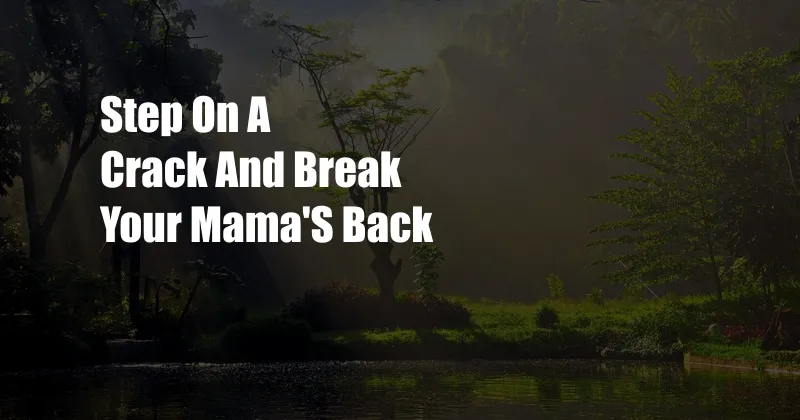
Step on a Crack and Break Your Mama’s Back: A Superstition Unraveled
We’ve all heard the old superstition: “Step on a crack, and you’ll break your mother’s back.” As children, many of us religiously avoided stepping on cracks in the sidewalk, terrified of the dire consequences it might bring upon our parents. But what’s the real story behind this peculiar belief?
The origins of this superstition are shrouded in mystery, but one theory suggests it stems from the mid-1800s. During that time, sidewalks were a relatively new concept, and their construction required breaking large slabs of stone into smaller pieces. The resulting cracks in the sidewalks were seen as a nuisance, and parents would often warn their children not to step on them, as they could trip and fall.
The Myth of Maternal Malady
However, the more sinister consequence – the one about breaking one’s mother’s back – was likely added later. It’s thought that mothers were seen as protectors, and children feared that by stepping on a crack, they were indirectly harming them.
Over time, the superstition evolved into the version we know today, where the consequences of stepping on a crack are not only physical but also supernatural. It’s worth noting that there is absolutely no scientific evidence to support the claim that stepping on cracks can cause any harm to anyone.
A Symbol of Resilience
In recent years, there’s been a growing movement to reclaim the “step on a crack” superstition as a symbol of resilience and perseverance. Instead of fearing the cracks in life, the superstition can be interpreted as a reminder that even when things break or don’t go as planned, we have the strength to keep going.
By acknowledging the cracks, we recognize the challenges and obstacles we face. But rather than letting them hold us back, we can use them as stepping stones to build strength and resilience. As the saying goes, “What doesn’t kill you makes you stronger.”
Modern Interpretations and Trends
The superstition has also taken on new meanings in contemporary culture. On social media, people often use the hashtag #steponthecrack to share stories of overcoming challenges or embracing their imperfections.
Additionally, some therapists and counselors use the superstition as a metaphor for dealing with emotional wounds. Just as stepping on a crack doesn’t actually break one’s mother’s back, holding onto past hurts doesn’t actually harm others. Instead, it’s up to us to heal our own wounds and move forward.
Tips and Expert Advice
While we can’t prevent cracks from appearing in life, we can choose how we respond to them. Here are a few tips and expert advice for embracing the “step on a crack” philosophy:
- Acknowledge the cracks: Don’t try to ignore or hide from challenges. Instead, recognize them as opportunities for growth.
- Embrace your imperfections: There is beauty in the cracks. Everyone has strengths and weaknesses, and it’s okay to own them.
- Learn from your mistakes: Cracked sidewalks can be tripping hazards, but they can also teach us valuable lessons. View mistakes as stepping stones to success.
- Seek support: Don’t try to go through life alone. Build a network of people who can offer encouragement and support when you face challenges.
- Focus on the positive: It’s easy to dwell on the negatives, but try to focus on the good things in life. Gratitude can help you overcome tough times.
By following these tips, you can use the “step on a crack” superstition as a reminder that you have the power to overcome obstacles and create a fulfilling life, regardless of the cracks you may encounter along the way.
FAQ on Step on a Crack, Break Your Mama’s Back
Q: Where did the superstition originate?
A: The exact origins are unknown, but it’s thought to have emerged in the mid-1800s when sidewalks were a relatively new concept and parents warned children not to step on cracks to avoid tripping.
Q: Is there any scientific evidence to support the superstition?
A: No, there is no scientific evidence to suggest that stepping on cracks can cause any harm to anyone.
Q: What are some modern interpretations of the superstition?
A: The superstition has been reclaimed as a symbol of resilience, perseverance, and embracing imperfections.
Q: How can I use the superstition to my advantage?
A: By acknowledging the cracks in life, embracing imperfections, learning from mistakes, seeking support, and focusing on the positive, you can use the superstition as a reminder of your strength and resilience.
Q: Are you saying superstitions are true?
A: The superstition has no basis in fact, but it can be a metaphor for dealing with challenges and embracing resilience.
Conclusion
The superstition “step on a crack and break your mama’s back” is a fascinating blend of folklore and modern interpretation. While its origins may have been in preventing children from tripping, today it carries a message of resilience and perseverance. By embracing the cracks in our lives, we can learn from them, grow stronger, and create meaningful connections with others.
Are you ready to step on a crack and embrace the unknown?